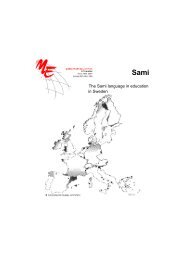Multilingual Early Language Transmission (MELT) - Mercator ...
Multilingual Early Language Transmission (MELT) - Mercator ...
Multilingual Early Language Transmission (MELT) - Mercator ...
Create successful ePaper yourself
Turn your PDF publications into a flip-book with our unique Google optimized e-Paper software.
of 180 study points whereof 20 are studies (6 courses) in languages (Swedish, Finnish and a<br />
foreign language), scientific writing and IT. Another 25 points are foundations of education:<br />
foundations of early childhood education, history and philosophy of early childhood<br />
education, sociological foundations of early childhood, child development and socialization,<br />
a course in how children learn and a practice period I.<br />
Thereafter follow 40 points in general early childhood and research related courses:<br />
multilingualism, the role of play, special education, educational planning, theory and<br />
teaching in preschool education, childhood psychology, socio-emotional development and<br />
family dynamics, qualitative and quantitative research methods, thesis seminar and thesis.<br />
The courses required for preschool teaching certification include media culture and media<br />
education, social interaction and belonging in a multicultural society, language development<br />
and stimulation, drama, mathematics, environment and natural sciences, religion and ethics,<br />
children’s literature, art, crafts, music, movement and health as well as practice periods II<br />
and III.<br />
In addition, students need to choose a minor consisting of 25 points. This could be, for<br />
example, in-depth didactic studies in literature, music or sports. Finally they can take 10<br />
points of whatever they like and these university courses do not need to be related to their<br />
teaching certificate.<br />
Since this program is a collaboration between two universities each university is responsible<br />
for the teaching and the costs of the teaching of half of the courses. The practical work is led<br />
by a steering group of three people from each of the universities.<br />
Themes of the program<br />
The program has three foci – multilingual education, identity and diversity, and esthetic<br />
education. The three themes are evident through separate courses but most importantly the<br />
intention is that they are incorporated in all the courses where it is appropriate. Hence, a<br />
course in play or drama also deals with how play or drama can be language stimulating as<br />
well as culturally sensitive at the same time. These foci are directly related to the position of<br />
the Swedish speaking population in southern Finland and in particular in the Helsinki<br />
metropolitan area. Unlike older generations the children and youth of today are frequently<br />
growing up in Finnish-Swedish bilingual families as well as in mostly Finnish speaking<br />
communities. Unfortunately no current statistics exist about the number of children in<br />
Swedish daycare centers coming from bilingual families, but of all children registered as<br />
Swedish speaking in municipalities with less than 19% Swedish speakers (such as those in the<br />
Helsinki metropolitan region) in 2005 were over 65% from bilingual families (Finnäs, 2010).<br />
In additional many Finnish speaking families place their children in Swedish daycare in order<br />
for the children to become bilingual. For the Finnish speaking children there are also socalled<br />
‘language baths’ or language immersion programs where the children quickly become<br />
functionally bilingual and can later continue their schooling in Swedish immersion schools<br />
(Harju-Luukkainen, 2007).<br />
115



